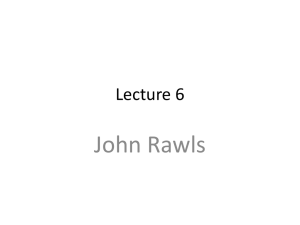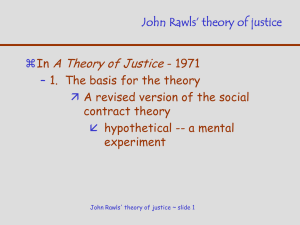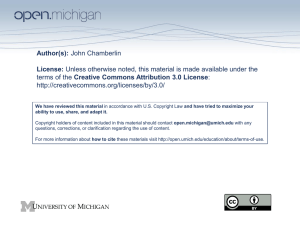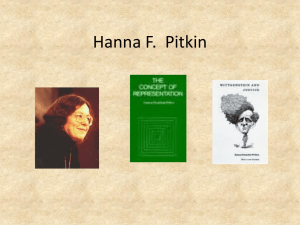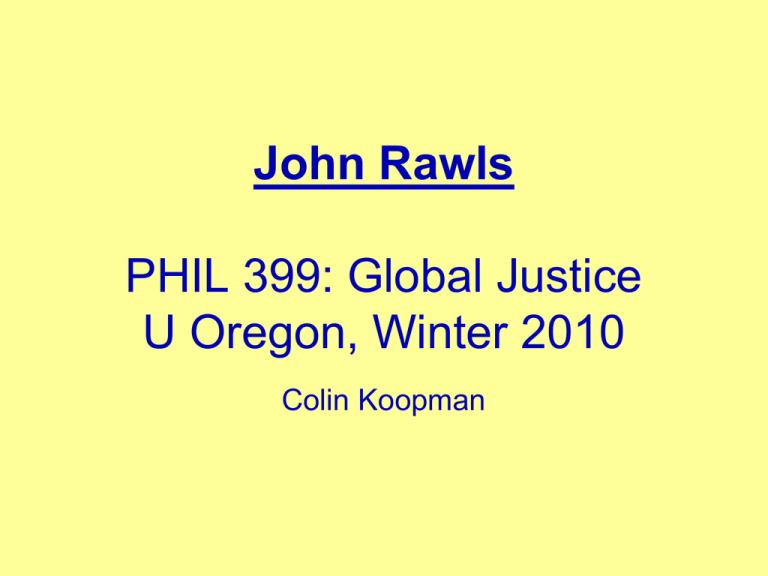
John Rawls
PHIL 399: Global Justice
U Oregon, Winter 2010
Colin Koopman
John Rawls (1921-2002)
Today’s Topics
1. Introducing Rawls
2. Four Roles of Political Philosophy
3. Rawls’s Fundamental Ideas
4. More on the Idea of the Basic Structure
Rawls’ Major Publications
•
•
A Theory of Justice (1971)
Political Liberalism (1993)
•
•
•
The Law of Peoples (1993/1999)
Lectures on the History of Moral Phil. (2000)
Justice as Fairness (2001)
‘Justice as Fairness’
•
Justice as Fairness: A Restatement (2002)
offers a compact and accessible restatement
of views developed at greater length first in A
Theory of Justice (1971) and later refined in
Political Liberalism (1993)
Historical Context for Rawls
•
Anglo Political Philosophy 1850-1950 took one
of two forms:
–
–
•
Dominant form included versions of social-scientific
utilitarianism and its variants (welfarism, rational
choice theory, economics)
Minor form included certain moralistic doctrines
which tried to bring justice relations into focus as
moral relations (utilitarianism, deontology).
Rawls revived normative political philosophy,
rescuing it from the social scientists, and is
largely responsible for the shape of analytic
political philosophy 1960-2000.
What is
Political Philosophy
Good For?
Four Roles of Political Philosophy
1.
2.
3.
4.
Practical
Orientation
Reconciliation
Utopianism
- Rawls, Justice as Fairness, §1, pp.1-5
Roles of Political Philosophy
•
Practical: “to focus on deeply disputed
questions and to see whether, despite
appearances, some underlying basis of
philosophical and moral agreement can be
uncovered” (2).
•
Political Philosophy helps us solve practical
political, policy, and legal matters.
Roles of Political Philosophy
•
Orientation: “contribute to how a people think
of their political and social institutions as a
whole” (2).
•
Political Philosophy orients how we approach
our political condition, how we think of
ourselves, and others.
Roles of Political Philosophy
•
Reconciliation: “showing us the way in which
[our] institutions, when properly understood
from a philosophical point of view, are rational”
(3).
•
Political Philosophy helps us understand the
advantages and values of current social order.
Roles of Political Philosophy
•
Realistic Utopianism: “probing the limits of
practical possibility” (2).
•
Imagining an ideal world which we can use as
a normative measure for current political
realities.
•
The blueprint conception of philosophy handed
down from Plato’s Republic.
What are the
Fundamental Ideas
of Political Philosophy?
Fundamental Ideas
•
A system of inter-related ideas which orient
how we ought to think about justice for the
practical purposes of reconciling ourselves
to the present and, more importantly,
imagining a better future.
Fundamental Ideas
•
Rawls believes that the fundamental ideas are
already more or less featured in contemporary
liberal democracies.
•
He sees himself as explicating the normative
or moral core of liberal democratic politics.
•
But he is also probing the limits of practical
possibility as a utopian would.
Role of Fundamental Ideas
•
The Fundamental Ideas frame how we should
go about the process of thinking about and
adjudicating matters of justice.
•
The Fundamental Ideas provide a framework
for political reflection and deliberation.
Frameworks and Principles
•
Rawls offers his own arguments for a more
Egalitarian Liberalism within the context of the
framework supplied by the Fundamental Ideas.
•
We can detach Rawls’ Fundamental Ideas
Framework from Rawls’ own Egalitarian
Liberalism, if we want to.
Rawls’ Fundamental Ideas
Social Cooperation
(Well-Ordered Society + Free & Equal Persons)
Basic Structure of Society
Public Reason
Original Position
The Six Fundamental Ideas:
listed on p.14 (§6.1) of Justice as Fairness.
Rawls’ Fundamental Ideas
Social Cooperation
(Well-Ordered Society + Free & Equal Persons)
Basic Structure of Society
Public Reason
Original Position
Reflective Equilibrum
Overlapping Consensus
Our Judgments, Beliefs, and Practices
The Fundamental Question
•
What is the fundamental question of political
philosophy for a constitutional democratic
regime?
•
“That question is: What is the most acceptable political
conception of justice for specifying the fair terms of
cooperation between citizens regarded as free and
equal and as both reasonable and rational, and (we
add) as normal and fully cooperating members of
society over a complete life, from one generation to the
next?” (8)
Social Cooperation
Three Essential Features of Social Cooperation
(6, §2.2)
1. Distinct from merely socially coordinated
activity
2. Includes the idea of fair terms of cooperation
that participants may reasonably accept
3. Includes the idea of each participant’s rational
advantage
Rawls’ Fundamental Ideas
Social Cooperation
(Well-Ordered Society + Free & Equal Persons)
Basic Structure of Society
Public Reason
Original Position
The Six Fundamental Ideas:
listed on p.14 (§6.1) of Justice as Fairness.
Rawls’ Fundamental Ideas
Social Cooperation
(Well-Ordered Society + Free & Equal Persons)
Basic Structure of Society
Public Reason
Original Position
The Six Fundamental Ideas:
listed on p.14 (§6.1) of Justice as Fairness.
Free & Equal Persons
•
The kinds of persons who we are developing a
theory of justice for.
•
The kinds of persons who will deliberate about
justice within the frame of the Fundamental
Ideas.
Free & Equal Persons
“Two Moral Powers” (p.18-19, §7.1)
•
Capacity for a sense of justice (i.e., is able to
treat others fairly whether they do or not)
•
Capacity for a conception of good (i.e., can
formulate a plan in which life is taken as
successful)
Free & Equal Persons
•
Persons who have capacities for both…
–
freedom (can autonomously pursue the good)
…and…
–
equality (can treat all others fairly)
Free & Equal Persons
•
Persons must possess both moral powers.
•
Not a theory for those who pathologically
pursue their own good without being able to
treat others as equals.
•
Not a theory for those so obsessed with
fairness that they cannot themselves form an
idea of what should be good.
Free & Equal Persons
•
“The conception of the person itself is meant
as both normative and political, not
metaphysical or psychological” (19, §7.2)
Well-Ordered Society
•
A society is well-ordered when it both…
–
“advances the good of its members”
…and..
–
“is effectively regulated by a public conception of
justice”
–
Rawls, A Theory of Justice, §1
Well-Ordered Society
•
A society with fair terms of adjudication
accepted by all free and equal persons within
that society.
•
A society possessing “[a] mutually recognized
point of view from which citizens can
adjudicate their claims” (p.9, §3.1)
Well-Ordered Society
•
“Existing societies are of course seldom wellordered in this sense, for what is just and
unjust is usually in dispute” (Theory, p.5, §1)
•
The idea of a well-ordered society is thus a
normative ideal which we should strive for.
Social Cooperation
•
The two normative Ideas of Well-Ordered
Society and Free & Equal Persons help us
explicate the Idea of Social Cooperation
•
Idea of Social Cooperation is really the core
starting point.
Social Cooperation
•
“The fundamental organizing idea of justice as
fairness, within which the other basic ideas are
systematically connected, is that of society as
a fair system of cooperation over time” (Rawls,
Political Liberalism, p.15, §3 [1993])
Rawls’ Fundamental Ideas
Social Cooperation
(Well-Ordered Society + Free & Equal Persons)
Basic Structure of Society
Public Reason
Original Position
Reflective Equilibrum
Overlapping Consensus
Our Judgments, Beliefs, and Practices
Basic Structure
•
Justice as Fairness “takes the basic structure
as the primary subject of justice” (10).
•
The basic structure is the place where fair
terms of social cooperation get put into
place.
What is the Basic Structure?
•
“The way in which the major social institutions
distribute fundamental rights and duties and
determine the division of advantages from
social cooperation” , (Theory of Justice §2)
•
Take a normal everyday social scenario and
try to determine the enormous amount of
apparatus that enables it to function as it does
on a regular basis.
Basic Structure
Portland, Oregon (1918)
Basic Structure
Some Elements of Basic Structure:
•
•
•
•
•
Laws (Rights, Statutes)
Major Social Institutions (Police, Fire)
Material Structures (Roads/Buildings)
Technological Infrastructure (Roads)
Social Relations (Race/Gender)
Basic Structure
Rotterdam, Netherlands (1940)
Basic Structure
Saigon, South Vietnam (Apr. 1975)
Basic Structure
•
A unifying idea that helps us see how
institutions, material reality, and social custom
“fit together into one system of social
cooperation” (10).
•
There is one and only one basic structure for
every society.
•
So, there is (or can be) one and only one
theory of justice for every society.
Importance of Basic Structure
•
“Our focus is almost entirely on the basic
structure as the subject of political and social
justice” (10).
•
This is where the theory of justice really does
its most important work.
Locating the Basic Structure
• Is there such a thing as a ‘basic structure
of society’ on a global level?
• Or does it make sense to speak of ‘the
basic structure of society’ only on the
national level?
Global/National Basic Structure
• If there is a global basic structure, then we
can perhaps develop a theory of justice for
global interconnectedness.
• If there is no global basic structure, then it
makes sense to talk about justice only at
the national leve.
Basic Structure
•
Basic Structure is where the Fundamental Idea
of Social Cooperation meets the Fundamental
Deliberative Ideals of Public Reason and
Original Position.
•
If the Basic Structure is just, then both our
terms of social cooperation above will be just,
and our everyday practices below will be just.
Working down to Basic Structure
•
We use the Fundamental Idea from above of
Fair Social Cooperation to see how we might
want to introduce normative constraints onto
our thinking about the basic structure.
Working up to Basic Structure
•
The Fundamental Ideas brought up from below
such as Public Reason and Original Position
help us understand how we might make the
basic structure just on the basis of our existing
everyday beliefs, practices, and conceptions.
Rawls’ Fundamental Ideas
Ideal political
constraints of social
cooperation, social
order, and citizens
Social Cooperation
(Well-Ordered Society + Free & Equal Persons)
???
Everyday beliefs and
practices as
constrained by fair
procedure
Public Reason
Original Position
Reflective Equilibrum
Overlapping Consensus
Our Judgments, Beliefs, and Practices
Rawls’ Fundamental Ideas
Ideal political
constraints of social
cooperation, social
order, and citizens
Social Cooperation
(Well-Ordered Society + Free & Equal Persons)
Basic Structure of Society
Everyday beliefs and
practices as
constrained by fair
procedure
Public Reason
Original Position
Reflective Equilibrum
Overlapping Consensus
Our Judgments, Beliefs, and Practices
Rawls’ Fundamental Ideas
Social Cooperation
(Well-Ordered Society + Free & Equal Persons)
Basic Structure of Society
Public Reason
Original Position
Original Position (OP)
•
Position in which parties agree or contract to
fair terms of social cooperation.
•
OP specifies a point of view from which fair
agreement can be reached.
Original Position (OP)
•
Rather than starting with what divides us…
•
Let’s start with what we all have in common
and what we would all tend to agree to…
•
How can we do this?
Veil of Ignorance in OP
•
“The parties are not allowed to know the social
positions or the particular comprehensive
doctrines of the persons they represent. They
also do not know persons’ race and ethnic
group, sex, or various native endowments
such as strength and intelligence” (15, §6.2)
Veil of Ignorance
Social Class
Gender & Sexuality
Comprehensive Beliefs
Race & Ethnicity
Political & Economic Structure of Society
Conditions of Religious & Philosophical Pluralism
Demand for Goods under Conditions of Scarcity
General Facts about Human Emotion & Rationality
Original Position (OP)
•
Hypothetical (we won’t actually do it)
•
Nonhistorical (it never actually happened)
•
The Original Position is a thought experiment
(“a device of representation”) designed to help
us understand how we should model fair terms
of agreeing to a social order.
Public Reason
•
Specifies how to go about reasoning about
Basic Structure fairly.
•
Public reason expresses the constraints on
reasoning that arise in the Original Position.
Public Reason
•
“…ways of reasoning and inference
appropriate to fundamental political
questions… beliefs, grounds, and political
values it is reasonable for others also to
acknowledge” (27, §9.2)
Public Reason
•
Let’s try to narrow disagreement…
•
…and start from what we agree on…
•
…and focus on kinds of reasons we all tend to
accept…
•
…so that we can fairly deliberate about how to
organize the Basic Structure of Society.
More on Rawls’s Key Idea:
The Basic Structure of Society
Rawls’ Fundamental Ideas
Social Cooperation
(Well-Ordered Society + Free & Equal Persons)
Basic Structure of Society
Public Reason
Original Position
Basic Structure
•
A unifying idea that helps us see how
institutions, material reality, and social custom
“fit together into one system of social
cooperation” (10).
•
There is one and only one basic structure for
every society.
•
So, there is (or can be) one and only one
theory of justice for every society.
When is ‘Justice’ relevant?
•
Where do we locate the basic structure in the ethics and
politics of everyday practices like, say, drinking coffee?
•
Is justice involved in everyday events like drinking coffee?
When is ‘Justice’ relevant?
When is ‘Justice’ relevant?
Justice between persons
•
•
Many political philosophers have theorized ‘justice’ as a
relation that holds between persons
Justice is a relation between the coffee customer and
the café owner.
Justice between persons
•
The relation between customer and café governed by
certain basic norms of justice (e.g., a no-harm rule).
–
–
Customer can’t justly steal the coffee…
Owner can’t justly spill the coffee on the customer…
Justice between persons
•
Justice may also hold between customer and coffee
farmers if we can trace harm (e.g., Fair Trade).
Justice in Basic Structure
•
•
Rawls thought of ‘justice’ as a relation that pertains to
basic social institutions that affect us all
Justice is a feature of the basic structures of society
Justice in Basic Structure
•
Don’t think of justice as a one-on-one relation between
two people or two groups.
•
Justice pertains to the basic structures of society that
makes things work the way they do.
•
“It’s the system, man!”
Addendum:
Contextualizing Rawls’s
Contributions to
Political Philosophy
Political Theory 1850-1950
•
Liberal Theorists: J.S. Mill, Herbert
Spencer, L.T. Hobhouse, Henry Sidgwick
•
Liberal Economists: Alfred Marshall,
J.M. Keynes, Kenneth Arrow
•
Increasing dominance of economists on
practical policy
Political Theory 1960-present
•
Revival of Normative Political Theory
(i.e., political philosophies saying how we
ought to organize ourselves)
•
John Rawls, Robert Nozick, Ronald
Dworkin, Thomas Nagel, Joshua Cohen,
Martha Nussbaum, Amartya Sen
Reviving Normative Theory
•
Concept of ‘the basic structure of society’
•
Provides a way for thinking about justice in
social-institutional terms. Justice used to be
thought of as person-to-person relations. Now
justice can be theorized as a social project.
Reviving Normative Theory
•
Concept of ‘the basic structure of society’
•
From near-exclusive concern with utility…
•
…to a wider theory that strikes a balance
between liberties (rights, privacies) in the
private sphere and social welfare in the public
sphere.
Reviving Normative Theory
•
Concept of ‘the basic structure of society’
•
The basic structure describes a singular public
sphere.
•
A singular public sphere the proper object of a
theory of justice.

